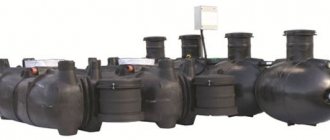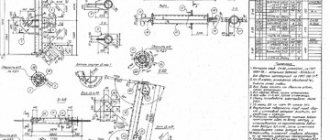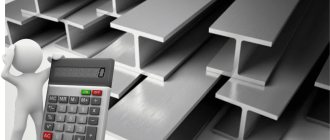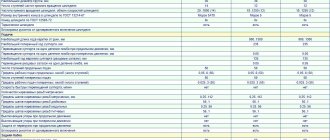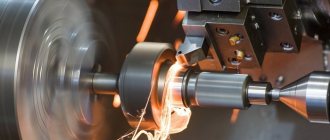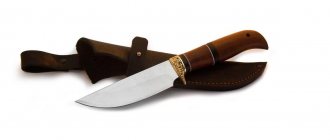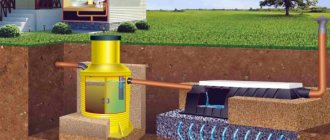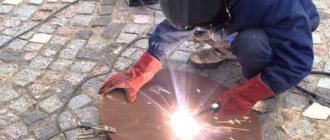Today, construction technologies are so reminiscent of the futuristic future that literally tomorrow houses will begin to be built from transparent concrete using another 3D printer. Even experienced professionals do not always have time to keep up with all the new products. And, although some of these materials have been used on the domestic market for a long time, they still have not become recognizable.
Thus, an I-beam made of wood or metal is considered quite underrated today. But strong floors and entire rafter systems are made from it! Moreover, such a beam has a number of advantages over conventional elements. But why is it still not in every home?
Because many are confused by its fragile appearance due to its thin internal rib. Although in fact the laws of physics work perfectly here, and in the right position the I-beam is in no way inferior to much more massive and heavy beams. How can this be? And now we will tell you!
What is an “I-beam”?
For many companies today, the priority is to build reliable and inexpensive houses, and in a relatively short time. And these problems are solved to a greater extent by the building materials used.
Until recently, the I-beam in Russia was used only in the industrial sector, but today it is becoming more and more popular. The emergence of new types of I-beams in recent years has made it possible to successfully use them in the construction of ordinary residential buildings.
In construction, an “I-beam” is a wooden or metal profile that has a cross-section similar to the letter “H”. The term itself comes from “taurus,” which means “bull horns.”
The assortment of I-beams on the domestic market is still small, because the product itself is still little known and few manufacturers represent it. But abroad, quite interesting types of it are used, where engineering thought and the laws of physics are combined.
Assortment of I-beams: range of materials of manufacture and section shape
The current standard defines several types of I-beams with different dimensional characteristics, weight and cross-sectional shape, which is determined by the range of materials.
H-shaped rolled metal products are characterized by different cross-sectional shapes. In a hot-rolled steel I-beam, regulated by GOST 8239-89, the flanges with the wall form an angle of 8-12°. The product is used as a support crane beam for telephere lines. A normal I-beam (according to GOST 26020-83), designated in the design documentation by the letter “B”, is made with parallel flange edges. This simplifies the production process while simultaneously reducing the profile's resistance to deformation.
A wide-flange I-beam (GOST 26020-83 designates the product with the marking “Ш”) has a shelf width increased by 1.5 times in comparison with the above types of rolled metal. This has a positive effect on the rigidity, strength and durability of the structure. Thanks to this, it is able to withstand a load 40% more than a normal beam.
Column I-beams according to GOST 26020-83 are designated by the letter “K”. The products have a maximum shelf width with increased thickness, which makes it possible to obtain a highly durable product. I-beams are used in the construction of particularly critical structures.
To create stairs, floors, supports, trusses, bridges and various hydraulic structures, a normal I-beam regulated by GOST 26020-83 is used. Wide-flange beams find their use in load-bearing structures of floors and staircases. In industrial construction, column structures are mainly used.
For stairs, a normal I-beam is used, which is regulated by GOST 26020-83
In accordance with GOST 8239-89 and GOST 26020-83, the assortment of I-beams contains the following range of materials that are used for the manufacture of I-beams:
- carbon steel of ordinary quality, regulated by GOST 380-2005, can be calm, boiling and semi-resistant, characterized by an optimal ratio of strength, technical characteristics and price;
- construction steel, in accordance with GOST 27772-88, is characterized by increased requirements regarding the content of harmful impurities in raw materials;
- aluminum alloy (according to GOST 4784-97) is used to create lightweight profile products, which are characterized by high aesthetic and corrosion properties;
- high-strength steel for bridge construction, meeting the requirements of GOST 4784-97, is used in the construction of particularly critical structures and has increased resistance to the influence of cyclic loads.
Advantages and disadvantages of I-beams
Let's list the main features of I-beams. And there are a lot of them!
Thanks to its special design, an “H”-shaped beam is in practice 7 times stronger than a standard square beam with the same cross-sectional area, and at the same time 30 times stiffer. Amazing, isn't it?
At the same time, an I-beam with an open cross-section (like an angle or a channel) has low resistance to torsion , 400 times less than a round pipe. Therefore, the load, constant and variable, must be calculated on the I-beam that will be used.
The constant assumes the weight of the material in the form of beams, insulation, floor and ceiling, and the variable assumes the weight of people and equipment on the floor. As a result of such precise calculations, the strength of the I-beam is beyond doubt.
During operation, the dimensions of I-beams remain stable and are not subject to shrinkage . The load-bearing capacity of such beams is up to 500 kg per linear meter, and one linear meter weighs only about 6.8 kg.
Thanks to all this, such beams are suitable for fairly long runs, up to 24 meters, and their installation does not require special lifting mechanisms (although with them, of course, all work goes faster).
By the way, I-beams differ favorably from trusses in that they are easy to trim if necessary , whereas this cannot be done with trusses.
The beams are quite light and convenient, they can be transported without problems:
Plus, the use of such beams affects how expensive and heavy equipment will need to be brought to the construction site, at what temperatures it is allowed to work, and how much the ceiling itself will weigh.
As for the price, we note that standard plank flooring, of course, is cheaper . But it is worth considering that the boards themselves additionally require intermediate supports, sheathing and many other additional parts. In addition, such a base periodically needs repairs, because we are talking about wood.
To summarize: I-beams are excellent as rafters, purlins and floor beams, as well as frame elements in low-rise construction.
Video description
Why the floor beam burst, watch the video:
In order to find out the load on the structure, you need to add the variable value and the constant value. The latter includes the preliminary mass of the beams themselves, insulation, ceiling lining, rough and finishing floors. Temporary includes the mass of furniture and people - approximately 150 kg/m2 - according to regulatory documents for residential premises.
For an attic, the value of the live load may be smaller, but it is better not to risk it and use the same one in the calculations. This way you will provide a certain margin of safety and in the future, if you wish, you will be able to equip an attic in the attic without reconstructing the load-bearing elements.
The calculation of a wooden beam is carried out using the following formulas:
- Mmax = (q*l2)/8;
- Wreq = Mmax/130.
q is the load per square meter. m of flooring, including the mass of structures and 150 kg of useful value. The indicated values must be multiplied by the distance between the beams, since calculations require loading per linear meter, and initially the value is calculated per square meter.
l2 is the distance between the load-bearing walls on which the purlin rests, taken in a square.
Knowing Wrequirement, you can select the section of the floor. W = b*h2/6. Knowing W, an equation with one unknown is compiled. Here it is enough just to set one geometric characteristic b (section width) or h (its height).
It is important! Despite the apparent simplicity of the calculations, it is better not to trust them to people without specialized education, since the cost of an error can be very high.
calculation of a wooden beam Installation diagram of floor beams Source centermira.ru
Wooden I-beams for low-rise construction
Wooden I-beams are most actively used today as load-bearing elements of floors and truss structures for buildings. Wooden I-beams are suitable for brick, timber, block and log houses.
Technical characteristics: strength and weight
Wooden I-beams are made from laminated lumber. Both belts are made of wooden blocks, which are fastened with OSB or a wood fiber insert.
Abroad, such beams are made from OSB and HDF, and in Russia there are several factories that produce such beams from OSB and plywood walls, the quality of which, however, still remains questionable.
Let's take a closer look at the technical characteristics of such I-beams:
This is what an I-beam rafter system looks like:
The very formula “wood + OSB + wood” allows you to avoid many of the disadvantages that you cannot do without when you have to use a solid wooden beam.
Comparison with other building materials
Let's list the main advantages of such beams. They are straight, because completely devoid of bending moments, because OSB will no longer “lead”. At the same time, the beams are quite strong and easy to install, because No special skills are required to install them.
Here is a comparison of a wooden I-beam and a regular edged board according to the main indicators:
Further, compared to wood, I-beams weigh much less, cover large spans perfectly and do not change their geometry over time.
At the same time, ordinary wooden beams run the risk of cracking, torsion and shrinkage:
Thanks to its special properties, the wooden I-beam is so rigid that it can span large spans without any intermediate supports.
Thus, gable beams and beams with parallel chords are used for load-bearing floors with spans from 6 to 15 meters! In this case, office and residential premises are quite spacious, which is especially fashionable today.
Moreover, these advantages are especially valuable when compared with materials that are more familiar on the Russian market. And the main advantage here is the weight of the I-beam:
By the way, I-beams are not used simultaneously with ordinary timber, because their shrinkage rates differ significantly. As a result, if you combine both types of material, after a year or two the ceiling will lose its horizontality, and the walls will no longer have even support.
Manufacturing materials: shelves and walls
The top and bottom chords of I-beams are made of solid or special modified wood, and the vertical filling is made of OSB or plywood.
The secret of all these advantages is that in the manufacture of I-beams, wood with a moisture content of no more than 18% is used. For this, two-component glue and stiffeners made of high-quality oriented strand boards are used, so such beams do not have problems with creaking or uneven floors.
High-quality beams do not lose their valuable physical properties due to changes in temperature and humidity, and cutting and adjusting I-beams is not difficult with the most common carpentry tools.
The bars in this design must be of a solid cross-section, and the joints must be made with a toothed tenon, which is made with a special cutter. Next, the wall is glued into the grooves of the beam chords. Stiffening ribs are installed at the ends of the beams. Next, the beams are protected with antiseptic coating or spray solution.
OSB is made from flat wood chips by pressing, and the chips, usually from softwood, are bonded with synthetic resins. Thanks to all this, the stove has high water-resistant characteristics. After all, here the pieces of wood seem to be intertwined and create a durable material without stress concentrators (in a word, homogeneous, identical along the entire length).
The material turns out to be of much higher quality than ordinary plywood. And at the same time even more elastic, thanks to which it perfectly holds construction staples, nails, screws and other elements.
Using such a framework has its advantages. Thus, natural lumber is not without its drawbacks; its quality is quite difficult to determine by eye. At the same time, artificial beams are as reliable and accurate as possible.
They have no defects, knots or deformations, they do not crack or rot. Structures obtained from such materials are called shape-stable. They do not creak like wood, they are more durable and rigid. Their production requires less natural raw materials and fewer requirements for its quality.
Here is a very interesting video on making wooden I-beams with your own hands:
Also, wooden I-beams are produced with a plywood wall. The shelves here are made of rectangular wooden blocks, with a wavy wall made of special waterproof plywood.
Although for many craftsmen, the word “plywood” in the interfloor ceiling causes horror. After all, we are talking about a colossal load! In fact, the laws of physics are at work here, namely the principle of pressure: try placing a piece of plywood on its edge, and see how strong such a position can be.
You've probably wondered why you can't use a regular board as a wall, especially since it's stronger than plywood or OSB?
In fact, such materials are hot-pressed during the production process, and therefore have a much higher density than ordinary wood. However, the board is indeed sometimes used, but only of dense wood, after professional deep impregnation and in more rare cases.
Series and types: modern range
The assortment of the I-beam indicates the characteristics of the beam: height, thickness and width of each element. So. wooden I-beams have the following types:
- “ BDK ” is a glued I-beam with a wide flange, designed for short spans.
- “ BDKU ” is a reinforced beam with a wide flange for long spans.
- “ BDKSH ” is a wide beam for rafter systems, loaded structures and especially long spans.
- " SDKU " is a reinforced beam for a wall frame.
- “ SDKSH ” is a wide stand for constructing a wall frame.
All of these options also have subtypes:
Sometimes, for some projects, I-beams are made in pairs, thereby increasing their rigidity:
By the way, there is another variation of a wooden I-beam: the beam belt is made of dry coniferous wood, and the connecting lintel is made of galvanized high-strength steel with a special polymer coating.
The wooden parts of the beam must be treated with a fire-retardant composition, because here there is contact between metal and wood.
Features of application and installation
The use of such beams is quite simple:
In real life, such a setup looks like this:
We also note that OSB beams have high strength and a convenient design, which allows you to carry out the necessary utilities directly in the floors.
Features of the I-profile design
An I-beam is a standard beam with a cross-section shaped like the letter “H”. Modern construction of bridge structures, floors, multi-story buildings or hydraulic structures is impossible without the use of this type of profile. It is also widely used in mechanical engineering. I-beams are quite varied in their design. This article provides information about the advantages of profiles made of different materials, their sizes and modifications. Data that will definitely be useful in the construction of civil and industrial facilities.
What is a channel: range, characteristics, areas of application (read more)
Since I-beams are a building material that is used in critical structures, their production is carried out strictly in accordance with state standards.
An I-beam profile is a type of rolled metal product made from high-quality profile steel. As a rule, structural steel without or with low alloying additives is used in the production of products.
I-beams have different weights and dimensional characteristics. To classify profiles, appropriate numbering and markings are used. This facilitates the process of selecting materials, taking into account the characteristics of the facility under construction and the expected loads on the structure.
It is difficult to underestimate the benefits of using I-profiles. These products, used in various fields, are resistant to high loads and impervious to external influences. They are durable, reliable, and affordable. The pricing policy of the products is also pleasing. The cost of the structures, compared to analogues, is modest, which is undoubtedly a plus.
When buying I-beams, you should definitely pay attention to their number; you can use it to find out the profile height. Wooden I-beams, the sizes of which are also varied, are widely used in frame house construction.
The use of profiles from this material allows you to reduce costs when laying the foundation, speed up the construction time of the structure, and also significantly reduce the overall weight of the building. The use of I-beams made of wood eliminates future problems associated with shrinkage, shifts, and shrinkage of the structure. A self-made wooden I-beam allows you to avoid the creaking of the finished structure, unsteadiness and vibrations inherent in ordinary frame buildings
Wooden I-beams, the sizes of which are also varied, are widely used in frame house construction. The use of profiles from this material allows you to reduce costs when laying the foundation, speed up the construction time of the structure, and also significantly reduce the overall weight of the building. The use of I-beams made of wood eliminates future problems associated with shrinkage, shifts, and shrinkage of the structure. A self-made wooden I-beam allows you to avoid the creaking of the finished structure, unsteadiness and vibrations inherent in ordinary frame buildings.
Note! Carbon steel beams are designed for indoor use where exposure to adverse weather conditions is excluded. For outdoor work or with increased requirements for structural strength, beams made of low-alloy steel should be used.
Steel I-beams for powerful buildings
Today, space-planning solutions can be so complex that it is impossible to do without load-bearing steel beams, because with spans of 7 meters or more, no concrete structures are effective.
Unlike a wooden one, a metal I-beam spans spans with a significant load, does not burn and is resistant to biological influences (mold, bugs). True, in the event of a fire, over time it can lose its load-bearing capacity, as well as corrode in the absence of protection. In addition, the metal I-beam is heavy and cannot be installed without special equipment.
But steel beams are not used for the construction of attic floors of houses, the foundations of which have a maximum load. Also, such beams will be quite heavy for walls made of porous, cellular materials and profiled timber, which shrinks over time.
Types of steel for making beams
I-beams today are made from rolled steel, aluminum alloys and cast steel. In this case, steel is an alloy of iron and carbon, with only small impurities and alloying additives. The most popular in this regard is low-carbon.
The steel itself may also differ in the production method, for example, into calm, boiling and semi-calm. And, depending on the properties of steel, it is made into regular steel and with increased or high strength.
Thus, low-carbon steels are steels of medium strength, and low-alloy steels already have increased strength. The strongest is medium alloyed.
Welded and rolled I-beams: what is the difference?
According to the type of section, steel beams can be rolled or composite, connected by welding. Hot rolling of beams is carried out on rolling machines - special installations with rotating rollers. To do this, take a thick ingot, which is moved along a roller table and the beam takes the shape of an I-beam.
During the rolling process, the ingots are moved along a roller conveyor and processed by a series of rolls, as a result of which the length of the workpieces increases greatly, and the cross-section gradually decreases and takes on the shape of an I-beam. This is a fairly productive method, but due to the use of complex equipment, it is not cheap.
But welded I-beams are produced on automated lines. To do this, blanks are cut, I-beam profiles are assembled and they are submerged. After this, the profiles will be further processed by rolling to achieve the ideal geometry of the shelves.
Next, the surface of the profile is cleaned and a protective coating is applied. Only with the help of welded technology is it possible to produce beams with the most accurate dimensions, thin-walled and multi-flange I-beams.
Welded beams are lighter, up to 30% lighter than hot-rolled ones, and are good because they allow you to use different types of steel in one structure. For example, there is one for shelves and another for walls.
Thus, the most stressed areas in it are made of high-strength steel, and the less stressed areas are made of low-carbon steel. This approach reduces the cost of the beam by 5%.
The beams themselves, in which several different grades of steel are used simultaneously, are called bistal. It’s simple: the walls in the beam are least loaded, and the chords are the most loaded. In the belts, steel of higher strength is used, and this is 14G2, 10G2S1.
By the way, the use of bistal I-beams is most appropriate for static loads. And compared to beams made of single steel, these will cost 5-15% less.
In itself, rolling such profiles is more productive than welding, but welded beams are easier to produce with the required parameters. For example, only the welding method can make beams 4 meters or more high.
Design features of steel I-beams
A metal I-beam is often made of different sections. For what? The fact is that the beam itself experiences different stresses along its length during its operation, and in some places it is significantly lower than the permissible one.
In addition, for different tasks, a certain bending of the beam walls is allowed. Which, by the way, cannot be done with a wooden I-beam. The curvature of the beam walls is calculated using the following formula:
Another popular method is to concentrate the metal in the ribs and reduce the wall thickness (this technique provides savings of 10-20%).
It turns out that in such places you have to use more metal than necessary, and this is already an overrun. Therefore, profiles with a variable cross-section are sometimes made in order to save money, although most beams have a profile that is constant along its entire length.
Series and numbers of steel I-beams
Metal I-beams have different purposes, and therefore their characteristics may differ. Thus, beams with parallel flanges are marked as follows:
- “ Sh ” are I-beams with wide flanges that can withstand significant loads.
- " U " - beams with narrow flanges for residential construction.
- “ D ” - I-beams with middle flanges.
- “ K ” - beams, specially produced for the construction of columns, are quite heavy and durable.
Based on the angle of inclination, beams are divided into the following types:
- “ M ” is a beam with inclined shelves for the construction of suspended tracks. Here the angle of inclination does not exceed 12%. At the same time, 12% and 16% are the maximum for the internal corner.
- “ C ” is an I-beam for strengthening mine shafts, with an angle of inclination of the edges of up to 16%.
According to the degree of accuracy, I-beams are classified as follows:
- “ B ” is a beam of normal manufacturing precision. Suitable for most construction tasks.
- “ B ” are high-precision products, specially designed for complex tasks where the smallest errors matter.
According to the shape of the shelves, metal I-beams are made in two types - with a slope of the internal edges of the shelves or with parallel ones:
And here are additional series of such beams:
There are also such subspecies:
Steel beams for building a house should be selected by a professional who has accurate calculations of the permissible load on the foundation and the construction project itself.
There is also a separate type of I-beam that combines wood and metal. This, by the way, has been used in Europe since 1970.
More information about some types of I-beam
Aluminum I-beam has a high degree of strength, usually made of AD31 (for house construction) or 1915 (high strength) alloys. It’s worth choosing this one if you have a goal to build the lightest possible structure. Among other things, aluminum is environmentally friendly and resistant to corrosion.
According to the location of the shelves, there are two subtypes of aluminum I-beams: with parallel edges and with sloped edges.
Along the length of the beam: I-beams with measured length, with multiple measured length and unmeasured length. The length of the aluminum beam is usually in the range from 1 to 6.7 lm.
According to the production accuracy, aluminum I-beams are made of normal, increased and high precision (depending on the application).
Depending on the condition of the material, there are beams: those that have not been subjected to heat treatment; annealed (M); hardened, aged naturally or artificially (T, T1); fully hardened, naturally or artificially aged (T4, T5).
The main types of coating used: anodized (An); paint and varnish liquid (Zl); liquid electrophoresis (LE); polymer powder (P); two-layer complex (K).
There is also a classification according to the conditions of use: normal (B); columnar (K); wide flange (W); necessary for the construction of overhead tracks (M) and for the reinforcement of mine shafts (C).
Column I-beam –
a metal structure with thick shelves, so it can be used as a load-bearing element of a building. It is made from rolled steel. Such columns are most often installed in spans of considerable size and under high crane loads. This type of beam is very popular because it has high strength, but in some cases it is advisable to replace it with a wide-flange beam. Compared to other I-beams, the column I-beam is the heaviest and most wear-resistant.
A wide-flange I-beam is a load-bearing beam structure with a metal profile, long flange edges that are parallel to each other, and a cross-section. Based on the number of spans in the building, the following wide-flange I-beams are used:
- split. They are mounted on one span. Lightweight, height to width ratio 1:1;
- continuous. Accordingly, they are mounted on several spans at once. Height and width have a ratio of 1:2.5 – 1:1.16.
The increased width of the shelves guarantees increased stability of this type of I-beam. That is why it can be mounted as an independent element that does not require additional parts. This helps reduce the amount of work required and also reduce costs.
An I-beam channel is a U-shaped steel product. Made from rolled sheets, it is used to impart stability and strength to the structure.
Based on GOST requirements, the maximum deviation in width (height) should not be more than 3 mm, the maximum deviation in length is 100 mm. Curvature is no more than 0.2% of its length, maximum deviation in mass is 6%.
The I-beam channel allows you to strengthen load-bearing structures and floors, thanks to the ability to bend. Now there is a huge range of channel sizes for various applications.
This material is more in demand in the construction of buildings where it is necessary to assemble solid frames, install interfloor ceilings, and reinforce walls.
Let's summarize. Main advantages of aluminum I-beam:
- high rigidity, excellent strength with relatively low weight. Due to their rigidity, these products are much stronger than their analogues. For example, based on calculations, a square profile with the same cross-section is seven times weaker.
- a symmetrical section is the most advantageous type of section, since the bending load is best distributed over it.
- durability, stability. Application of various anti-corrosion coatings helps maintain the quality of aluminum I-beams for many years. It is able to withstand both low and high temperatures, and is resistant to mechanical influences from the external environment.
Corrugated beams: great savings
Although the corrugated beam looks interesting, in Russia such a design began to be used back in the 30s of the last century. Then something similar was used in wooden structures. Today, such beams are welded in several metallurgical plants in the country.
Now this type of beam is a welded lightweight structure made of corrugated sheets, which is welded to steel shelves. Moreover, the shelves themselves are made of hot rolled steel, and the profiled sheet is cold rolled.
Look what these beams look like:
The idea of corrugating the walls of such beams was arrived at in order to save money, or, to put it in literate language, to reduce the metal consumption of construction. Naturally, the corrugated wall can be thinner than a regular metal one (only 1.5-1.8 mm), because it already has transverse ribs.
Which, in addition, also increases the torsional rigidity of the beam itself! And, therefore, it allows you to get rid of the main drawback that is characteristic of the I-beam. Here the stress develops only at the belts, drops almost to zero, and all tangential stresses are evenly distributed along the height of the walls.
The corrugation itself can be either wavy or triangular (this is considered more technologically advanced). An even stronger beam does not have vertical corrugations, but horizontal ones.
In total, the corrugations are located to the upper belt at an angle of 45-50°, with the calculation of the ratio of the wave height to its length from 1/5 to 1/20.
Compared to conventional hot-rolled I-beams, corrugated beams are 20-40% more economical. Not only do such beams weigh less, but the profiling itself gives greater rigidity during rotation, and therefore fewer special lifting devices are used in the installation of such beams in the form of additional angles and ties. This greatly simplifies installation.
Corrugated beams are good as roofing purlins with a span of 9 m and as a load-bearing base in high-rise buildings with spans up to 24 meters.
The only significant drawback of such structures is that they are quite labor-intensive to manufacture. But, due to the fact that such beams do not have stiffeners, metal consumption and the length of welds are reduced.
Design parameters according to the range of I-beams
When selecting I-beams to perform a certain type of task, you should take into account their main parameters:
- height - the distance between the I-beam shelves;
- width – the size of the gap from the base of the product to the end of the shelf;
- wall thickness, which is calculated based on the base of the product and determines the strength and load-bearing capacity of the structure;
- the average thickness of the shelf, determined by subtracting the wall thickness from the width of the shelf, dividing the result by 4;
- the radius of the internal curve formed by the adjacent shelves, which takes on the greatest load, determining the charge of rigidity and strength of the product.
Perforated beams: increased load-bearing capacity
The final cost of any product is directly affected by such a concept as cost. Even at the beginning of the twentieth century, for the sake of economy, engineers actively developed and tested bending elements in building materials. So they came to the conclusion that designing beams with a perforated wall is more appropriate than I-beams with solid walls.
Due to the increase in the height of the beam and the presence of holes in it, the cross-sectional material is redistributed closer to the flanges, and there the normal stress (that’s the term) is greater. That is why simply increasing the height of the section by one and a half times increases its resistance by the same amount and doubles the moment of inertia.
In wooden I-beams, the internal holes are located one at a time, while in steel ones they are often made at regular intervals.
I-beams with internal holes
A round or rectangular hole is often made in such beams. Also, to increase the strength of the beam, corners are cut along the radius in the rectangular holes. In addition, you cannot make cuts directly on the beam flanges. The hole itself, usually 38 mm in diameter, is made anywhere in the rack except directly above the support.
If there are several holes, then certain recommendations are followed. But in the rack the beams leave a gap of 6.5 mm between the border of the hole on the bottom and top sides and the shelf.
Next, adhere to the following rules for making holes:
- the length of the rectangular hole should not be more than one and a half times the height of the hole made;
- the distance between the edges of round holes should not be more than 2.5 times;
- the distance between the edges of rectangular holes should not be more than 5 times the length of the largest rectangular hole;
- The distance between the edges of a rectangular and a round hole must be no less than 5 times the length of the largest rectangular hole, or 5 times greater than the diameter of the largest round hole:
Through I-beams
In technical terms, a perforated I-beam is a multiple statically indeterminate system. To put it simply, such a beam is similar in design to a braceless truss, and is even calculated using its formulas.
The whole secret is that in the middle of the walls and piers in the places of the holes there are points with zero moments, and in them there are conditional hinges. In such a beam, transverse and longitudinal forces interact. And how exactly depends on the pattern of cuts on the walls.
Beams with a perforated wall are required when it is necessary to increase the load-bearing capacity of rolled I-beams. Here the height of the perforated wall is simply increased, thereby increasing the rigidity and load-bearing capacity of the beam itself. Sometimes braces are also used.
To produce such a beam, it is cut during the production process using gas cutting or a powerful process in a zigzag broken line, with a so-called regular step. Then both halves are connected by welding where the wall protrusions touch. The shape of the broken line and internal holes vary widely, depending on strength calculations.
As a result, a perforated beam weighs the same as a rolled profile, but has higher rigidity and load-bearing capacity, and therefore is used on spans of greater width.
But, although the use of steel in such a beam saves up to 30%, the manufacturing itself is more expensive, because it is more complicated. But in practice, the height of a through I-beam turns out to be 1.3-1.5 times greater than a regular one, and therefore 1.5-2 times greater than the moment of inertia of the section. Thanks to this, the load-bearing capacity of a through I-beam, compared to a non-through one, is 1.3-1.5 times greater!
If you're interested, here's an interesting video about how forces are actually distributed inside a steel beam and why there's no need for extra material:
And at the same time, if a through I-beam is made bistal (from different types of steel), then with the same load-bearing capacity the beam is 34-39% lighter and 16-20% cheaper than solid hot-rolled or low-carbon steel. In a word, such an I-beam is even more compact, transportable and manufactured at the factory using highly automated equipment.
Thus, internal cuts can be symmetrical or asymmetrical with respect to the vertical axis. To make a symmetrical cut, the beam is connected from two halves from different two-piece beams.
This results in two types of beams: with inserts on supports and without them. But with an asymmetrical cut, only one type of beam is produced, in which one end is left without an insert, and the other has an insert.
Sometimes perforated I-beams are made from blanks of different I-beams. But then in the compressed zone it is necessary to install a half made of a stronger I-beam with stronger steel. This is how they achieve stability of the walls of the compressed belts. The very presence of holes in the wall distributes normal stresses over the entire height of the beam.
In addition, through I-beams are so strong that with a certain strengthening of their upper part of the wall, they are actively used as crane beams.
Options for manufacturing profiles according to GOST for I-beams
GOST standards for I-beams determine that products can be made in two ways. The first option involves the production of profiles by rolling from blanks 3-12 m long, which are processed at a temperature of 1200 °C. This process is carried out on special machines. The production uses structural steel, which does not contain alloying additives.
This technology facilitates the rapid production of monolithic products. Such elements exhibit increased resistance to various types of mechanical stress. The technology makes it possible to use building parts without the use of additional stiffeners.
The unique shape of the product allows you to reduce the weight of the structure, while increasing its load-bearing capacity. Shelves that evenly distribute the load eliminate the possibility of the structure warping.
I-beams can be manufactured by rolling from blanks and by welding three main elements
The H-shaped profile can also be made of three elements using welding. This technology makes it possible to obtain a part with a smaller cross-section in comparison with monolithic structures.
The process of welding an I-beam occurs in the following sequence:
- cutting steel sheets on CNC machines;
- welding of metal blanks on automated installations using hydraulic clamps;
- editing of structures based on the parameters prescribed by the standard.
Using the welding technology method, it is possible to obtain I-beams, the price per 1 meter of which depends on their geometric parameters, different widths and thicknesses of the shelves. You can order a product of a certain length with cutouts and holes for fastening in the profile body.
For greater reliability of the H-shaped beam, the elements to be connected are welded on both sides
If I-beams are produced using modern equipment, the products are not inferior in their technical characteristics to their hot-rolled counterparts. When using outdated equipment and low-carbon steel grades, building elements will be characterized by low performance indicators.
What types of beams are there?
Construction beams, like almost all materials used on construction sites, are classified into different types, focused on specific work.
Wooden
The range of beamed wood products used, respectively, in wooden buildings includes logs, crossbars, purlins, crossbars, and other elements that make up the frame of a timber or log residential country house. When dividing floors, floor beams are used. To construct the roof, a beam frame is built, where rafters are used. The main function of wooden beams is to distribute the load evenly along the plane of the top covering (roof). The qualitative characteristics of the material are the key to the strength and stability of the structure.
Reinforced concrete
In construction, the installation of reinforced concrete, for example, in industrial enterprises, takes into account the inclusion of corresponding products in the construction of crane beams, concrete crossbars installed on columns, under floor slabs.
Reinforced concrete beams are a linear type building element. Made from high-quality concrete with steel reinforcement located inside for reinforcement, they are designed to redistribute the load and increase the stability of the main structure.
Metal
Metal structures in construction include horizontal and inclined steel beams as an important part of the rigid frame. More often these are I-beams with parallel edges. Their main types are wide and columnar. The latter are not designed to withstand increased loads, therefore, when installing supporting parts that absorb the influence of the main acting forces, wide-floor beams are used. They are used in the construction of overhead tracks, mine shafts, and so on.
Supports
The beam itself rests on supports. Depending on the design features, the parts are:
- split: two supports support a building element between floors, in the roof of a roof or bridge spans;
- continuous: several supports hold the beam, deflection in one place affects the entire beam load.
Depending on the number of support links, these elements can be classified into types:
- statically determinable: when the number of bond reactions is equal to the number of independent static equilibrium equations;
- statically indeterminate: when the number of connections is greater than the possible equations of static equilibrium.
Cross section as a form of classification
Steel beams can be classified by end section. Such a classification in construction makes it possible to distribute the corresponding elements in the metal assortment and, thus, to select products. For example:
- Rectangular section. Suitable for use in short spans.
- Section type "L". Intended mainly for the construction of building facades.
- Section type "T". Belongs to standard and gable T-beams. They are optimally suited for the installation of medium-length spans.
- I-section. Beams are endowed with increased stability and are used for long spans. In turn, the I-beam can have parallel flange edges. Their parameters vary in accordance with the standards and established GOSTs.
- "V" type section. Such a construction beam plays the role of an additional product to strengthen the supporting structure.
- Section type "VT". Corresponds to purlins.
Thus, hollow supports usually find their use in light constructions of a garage, a small store, or a small shed.
Solid beams are quite suitable for ceilings in the attic of a simple wooden house. Various “T-type options” are designed for more severe loads in multi-storey buildings and industrial buildings. I-beams are the most popular on large construction sites, as they cope well with bending loads in roofing structures. To give them the greatest strength, such beams are produced with a thick wall, with internal edges sloping or parallel.
But trapezoidal horizontal supports are the strongest and most expensive.
Requirements of GOST 26020-83: assortment of hot-rolled steel I-beams
This standard specifies hot-rolled steel H-sections having parallel edges. The dimensions of the I-beam are strictly regulated by this GOST. The height of the product shelves is in the range of 100-1000 mm, and the width is 55-400 mm.
In contrast to the dimensions of the channel manufactured in accordance with GOST 8240-97, the I-beam assortment is characterized by a wide range of thickness values, which is in the range of 100-600 mm. Such I-beams can be normal – marked “B”, wide-flange – “W”, column – “K” and additional – “D”.
The range of wide-flange I-beams defines profiles with a height of 193-718 mm, which can be used without additional fastening. Such products are used as a basis for laying reinforced concrete slabs or steel sheets.
This type of element can withstand significant loads, so it is often used in the construction of multi-story buildings. Wide-flange I-beams 50Ш1 are used to make T-profiles for lattice structures.
Beams are produced in the following lengths: measured, unmeasured, measured with a segment, multiple measured, multiple measured with a segment from 6 to 24 m. This value is defined as the maximum value of the length of a conventional cut profile with ends perpendicular to the longitudinal axis.
